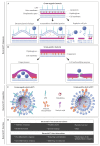Microbiota-host communications: Bacterial extracellular vesicles as a common language
- PMID: 33984071
- PMCID: PMC8118305
- DOI: 10.1371/journal.ppat.1009508
Microbiota-host communications: Bacterial extracellular vesicles as a common language
Abstract
Both gram-negative and gram-positive bacteria release extracellular vesicles (EVs) that contain components from their mother cells. Bacterial EVs are similar in size to mammalian-derived EVs and are thought to mediate bacteria-host communications by transporting diverse bioactive molecules including proteins, nucleic acids, lipids, and metabolites. Bacterial EVs have been implicated in bacteria-bacteria and bacteria-host interactions, promoting health or causing various pathologies. Although the science of bacterial EVs is less developed than that of eukaryotic EVs, the number of studies on bacterial EVs is continuously increasing. This review highlights the current state of knowledge in the rapidly evolving field of bacterial EV science, focusing on their discovery, isolation, biogenesis, and more specifically on their role in microbiota-host communications. Knowledge of these mechanisms may be translated into new therapeutics and diagnostics based on bacterial EVs.
Conflict of interest statement
The authors have declared that no competing interests exist.
Figures

References
Publication types
MeSH terms
LinkOut - more resources
Full Text Sources
Other Literature Sources

